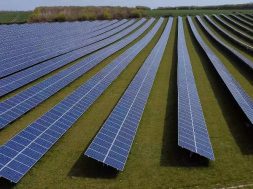
ZSW Sets New World Record for Thin-film Solar Cells
The Centre for Solar Energy and Hydrogen Research Baden-Württemberg (ZSW) has nudged up the performance bar for thin-film solar cells yet another notch. The Stuttgart-based scientists achieved 22.6 percent efficiency with their latest advance, topping the performance of a Japanese-made cell by 0.3 percentage points and bringing the world record back home to ZSW for the fifth time. And the pace of advances is picking up as recent strides in cell performance go to show: The efficiency of thin-film solar cells based on copper indium gallium diselenide (CIGS) has increased more in the last 3 years than in the previous 15. As efficiency goes up, the cost of solar power comes down.
The researchers in southwestern Germany are sprinting from one suc-cess to the next. It was just three months ago that the team achieved 22.0 percent efficiency with a cell that outperformed everything the scientists had developed to date, setting a European record in the pro-cess. The cell that upped this mark another 0.6 percentage points was made in a state-of-the-art laboratory coating plant using the co-evaporation method. The Fraunhofer Institute for Solar Energy Sys-tems ISE has confirmed the results.
ZSW’s record-setting cell has an area of about 0.5 cm², a standard size for test cells. The institute’s researchers accomplished this latest performance boost by improving the manufacturing process at several points, one being the post-deposition treatment of the CIGS surface with alkaline metal compounds being incorporated into this layer.
Soaring efficiency rates
Momentum has been building in thin-film photovoltaics (PV) in recent years. Records were few and far between from 1998 to 2013, with cells holding the best mark for as long as two or three years. Efficiency increased by just 0.1 percentage points a year on average. In the last three years, though, the world record has been eclipsed every six months or so, with an average increase of 0.7 percentage points per year.
With these latest advances in R&D, thin-film cells could soon be a se-rious contender for the silicon-based solutions that have dominated the PV market for years. Multicrystalline silicon cells’ lead is now 1.3 per-centage points.
Still no end in sight
As impressive as recent advances may be, ZSW researchers still see plenty of untapped potential in the technology behind CIGS solar cells. “I expect that we can achieve up to 25 percent efficiency in the years ahead,” says Prof. Michael Powalla, ZSW board member and Head of the Photovoltaics division.
Thin-film cells are also making strides in other areas, as key perfor-mance indicators would go to show: CIGS PV technology is catching up to multicrystalline silicon when it comes to entire modules’ efficiency (whereby the larger module is always slightly less efficient than smaller cells). The two technologies are not very apart these days with 15 to 17 percent efficiency, respectively. At 40 US cents per watt, the cost of manufacturing CIGS modules has also come down to a level on par with that of silicon technology. Scientists are confident that modules’ efficiency ratings could reach 18 percent or even higher, with produc-tion costs dropping to around 25 cents per watt. While the price of sili-con PV products depends largely on economies of scale, CIGS mod-ules can be manufactured at low cost even on a relatively small scale.
In the months ahead, ZSW will team up with its industry partner Manz AG to port this latest advance out of the lab and into the factory. Manz, a mechanical engineering firm based in Reutlingen, offers turnkey manufacturing lines for CIGS thin-film solar modules.
















